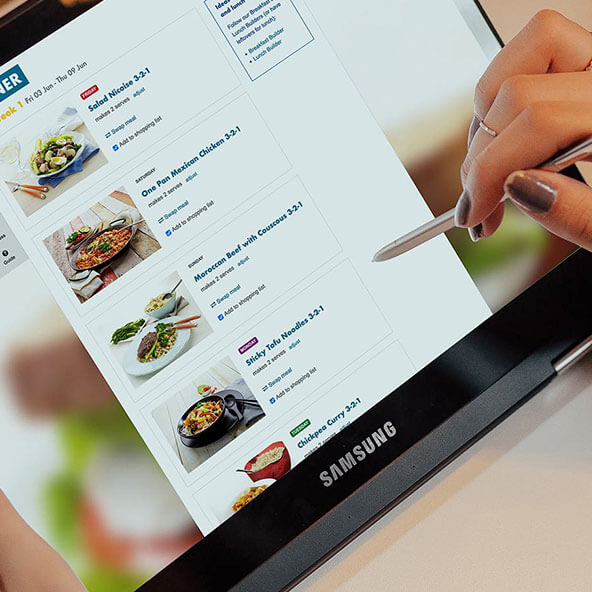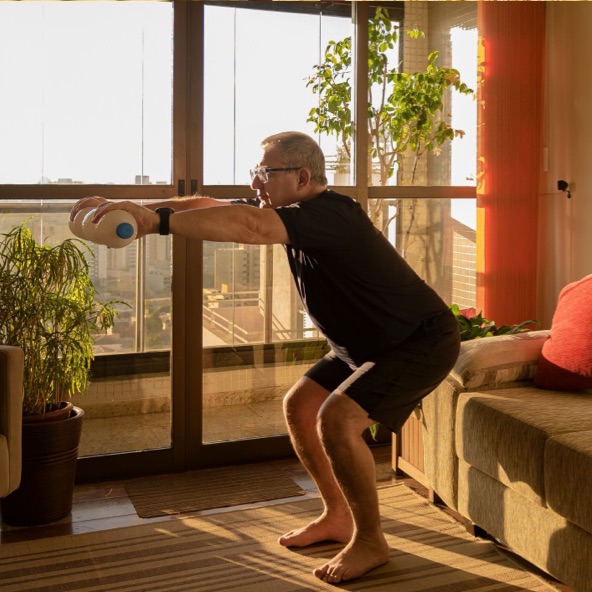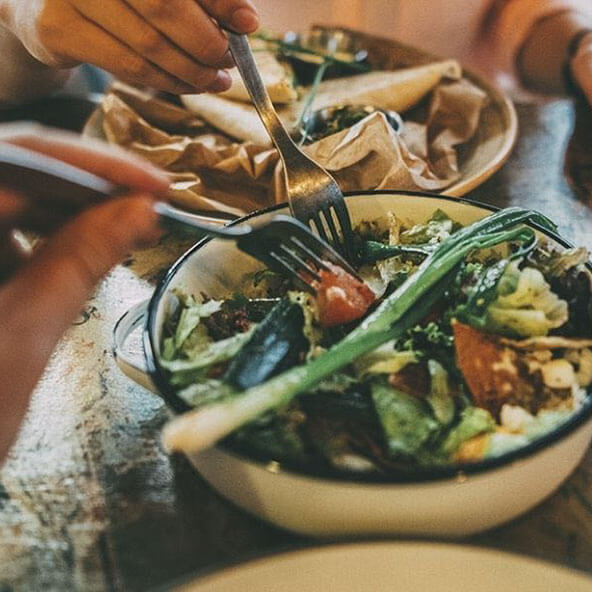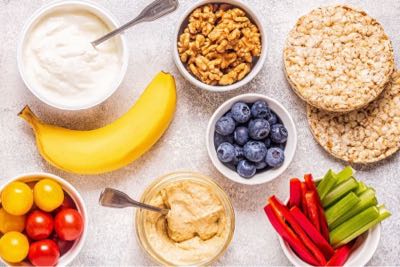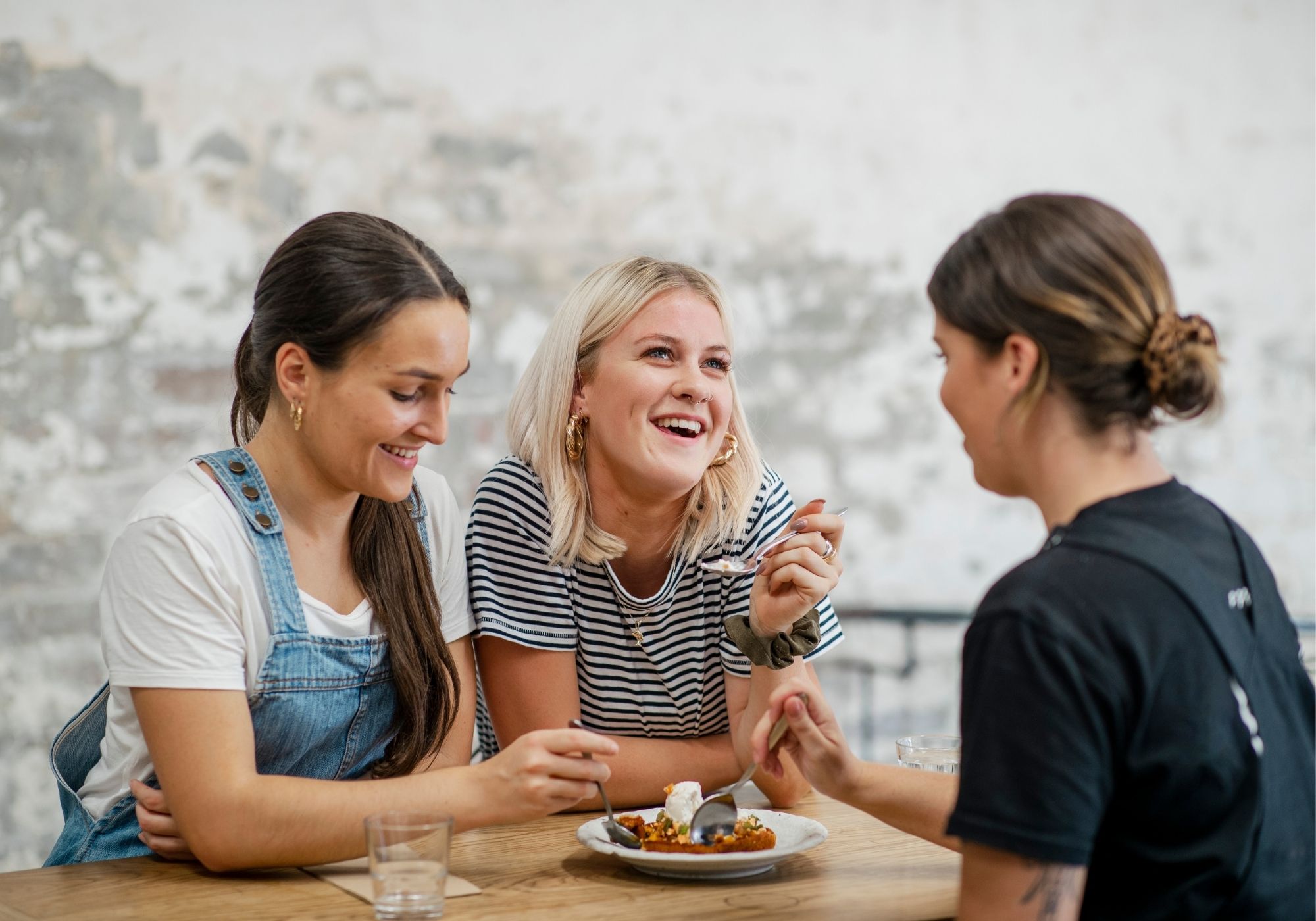
Make Healthy
Your New Habit
Looking to make a change?
Choose a habit you want to work on from the options below. Click for tips and resources to help you get started!
buy fewer lunches at work
Packing our own lunch for work is a great way to save money and help us avoid the temptation of ordering in greasy takeaway when we're under the pump.

Desk drawer pantry
Plan to forget by having some shelf-stable staples ready-to-go at home or work. Use these as an emergency back-up or as a base to add a few fresh things from home. Here are a few of our favourite desk drawer pantry items to stash:
- Grainy crackers, rice cakes and wraps
- Tinned tuna and salmon
- Microwave rice and noodles
- Tinned vegies and beans
- Baked beans
- Nuts and seeds e.g. cashews, peanuts, flaked almonds, sunflower seeds
- Chilli sauce, reduced-salt soy sauce, vinegar, flavoured oils
- Oats, muesli or weetbix
- Tinned/bottled fruit in juice
- Nut butters
- Long-life milk

Get salad/sanger savvy
It doesn’t get much easier than a sandwich, a piece of fruit and a handful of nuts if you’re looking for a healthy, no-nonsense work lunch. Level up your sandwich and salad game with these tricks to avoid soggy sangers and prep substantial salads. We also have a great visual guide to salads and sandwiches that slap.

Healthier lunch options when eating out
For those days when the desk drawer pantry has dwindled and you don’t manage to make lunch at home seeking out healthier lunch options is a great alternative to greasy takeaway. Here are some of our favs:
- Sandwich loaded with salad
- Cheese and tomato toastie
- Vegie-filled soup with crusty bread
- Sushi
- Fresh rice paper rolls
- Stir-fry noodles with lots of veg
- A hearty salad
- Vegie quiche or frittata and salad
schedule exercise
There are so many different ways we can move our body. The key is to find something we enjoy doing that fits in with our schedule. You may find you have to experiment with different styles of movement to learn what your body likes to do. Ready to reap the mental and physical health benefits of moving more? Let’s go!

Switch up socialising
Instead of scheduling a catch up with friends to see a movie or have a drink try something active instead. Find something you’ll all enjoy like going for a jaunt around your neighbourhood, doing a yoga class together, taking a dip in the ocean, going for a hike, joining a running club, riding your bike along the river, or even something left of field like indoor rock climbing. It’s all good stuff, and counts towards the recommended amount of physical activity.

Add a quick stretch or workout to the day
Add a recurring calendar event to your Outlook or set an alarm on your phone for a daily (or more often) movement snack. We’ve got a bunch of FREE micro-routines designed for different abilities that you can slide into your day.

Find everyday opportunities to move
This one’s all about sneaking extra movement into activities we don’t normally think of as exercise. Short bursts of activity throughout the day really add up, helping us to reach the recommended physical activity levels. Here are some ideas:
- Commit to always taking the stairs when the option is available.
- Walk your dog each day. Even if you can only manage a quick one some days, getting out there will keep your furry friend happy and do wonders for your health.
- House tasks like gardening, cooking and vacuuming all count as physical activity – get your house in order while moving more.
- Walk, cycle, run or take public transport to work or school on one or more days.
- Park a bit further away from your destination than you need to so you can get in some extra steps.
have less packaged snacks
When we’re feeling snacky, we tend to reach for the easiest and most accessible options we can find. Making wholesome foods as easy to grab and go as possible can help us in reaching our health goals.

Reduce the junk
A pantry full of chips and chocolate is very hard to resist when hunger hits. Make life easier for yourself by only choosing one treat item to buy during the weekly shop. That way, you won’t have a bunch of brightly packaged snacks in your pantry that you need to rummage through to get to the good stuff.

Prep for a snack attack
Help your future self out by pre-chopping some vegies for the fridge that you can munch on when a snack attack hits. Grab some dip from the shops (hummus, tzatziki or whatever floats your boat) to level it up.
You could also prep a big fruit salad (squeeze some citrus over it to slow down the browning) and store it in a sealed container in the fridge, bake a batch of tasty goodies for the freezer, or whip up some chia puds for a sweet morning or afternoon snack.
Order less fast food for delivery
Are you sick of paying top dollar for disappointing delivery? We hear you! Setting a goal to cut down on food delivery can save us a tonne of cash while also helping us eat healthier. For example, if you usually order twice a week, could you cut down to once a fortnight? Not feeling totally deprived is the name of the game. Here are some ways to pivot to healthier options for those times you need a meal but can’t face cooking.

Make food at home - but make it easy
Sometimes, life happens, and we don’t always have the energy or time to make a capital M ‘Meal’. There are lots of tasty throw together meal options that are much quicker, healthier and cheaper than delivery.
Breakfast for dinner is a nutritious and easy way to make a quick meal. Some of our favourites are:
- Eggs on toast with smashed avo
- Baked beans (store-bought or homemade) on toast
- Muesli with fruit and yoghurt
- Cheese and tomato toastie
- Cream cheese, cucumber and salmon bagel
- Smashed peas
- Frumpets (yes, that’s French toast crumpets)
- Spinach and mushroom omelette
- Eggs in a basket
- Smoothie
- Crispy egg wrap
- Ricotta, tomato and pesto on toast
Snack plate dinners are about pulling together whatever odds and ends you have on hand to make enough for a meal. The trick is to include at least one item from each group:
- Fruit and veg – e.g. cherry tomatoes, carrot sticks, gherkins, sliced apple, leftover roast veg, frozen peas, canned corn
- Protein foods – e.g. cheese, hummus, boiled eggs, leftover cooked chicken, nuts, tofu pieces, canned fish
- Grains – e.g. wholemeal or grainy bread, leftover rice, quick cook noodles, grainy crackers, rice cakes

Plan ahead
When you have a bit more time and energy cook up a big batch of your favourite freezer-friendly meals. Big-batch cooking saves on time and dishes, and means you’re prepared for those days when you just… can’t. Your future self will thank you when dinner is just a quick thaw away.
have less sugary drinks
You know what? You’re sweet enough already 😍. Sugary drinks are the single biggest source of sugar in the Australian diet. And with 16 teaspoons of sugar in a 600 mL bottle of soft drink, cutting back on this one product can make a big difference to our health. Try these tips:

Look for 'low sugar' on the label
While unsweetened drinks like still or sparkling water, plain milk, tea and coffee are the best option, low-sugar drinks with less than 2.5 g sugar per 100 mL (and no intense sweetener) can add variety.
For an occasional sweeter drink, choose something with less than 5 g sugar per 100 mL, which is about half the amount in a regular soft drink.
don't default to driving
Whether we’re heading out for work or play, many of us default to driving as our main way of getting around. Mix it up by trying one of these ideas:

Take public transport one day a week
Taking public transport instead of fighting our way through traffic is a great way to ease into the day, as well as decompress afterwards. Listen to a podcast or playlist, read a book, play Wordle, or keep it simple with some good old fashioned people watching.
Heading out to an event? Check your ticket as sometimes public transport is included. Gather your crew and make it about the journey, not just the destination.

Cycle or walk for transport one day a week
Transforming your commute time into exercise time is a solid swap for anyone who might otherwise struggle to fit exercise into the day. Walking, cycling or running to work or school is also good for the environment and can save a bucketload in petrol, parking costs and wear-and-tear on your vehicle. If your end-of trip facilities at work leave something to be desired, try only walking or running the journey home.

Park further away
If active transport isn’t an option for you, another approach is to park further away from your destination to help get some extra steps into your day. This can also save money by parking in less convenient places, and give you a little warm up for or cool down from the working day.
make monochrome meals more colourful
Do your plates look a little drab with mainly shades of brown or white? Add more colourful veg to your meals with these tips:

Try frozen and canned varieties
Frozen and canned fruit veg are a great option if you like the idea of eating more produce but struggle to find the time and energy for cooking. Frozen and canned varieties are often pre-chopped and ready to add into your dish, meaning less preparation time and cleaning. They also have a much longer shelf life (yay for less food waste!) and are often cheaper than fresh fruit and veg.

Explore different preparation styles
Were you scared away from vegies at young age by soggy boiled broccoli and Brussels sprouts? It doesn’t have to be that way! Many vegies shine when roasted (pumpkin, cabbage, cauliflower and potato are some of our favs), some are great in dips (think avo in guacamole, chickpeas in hummus and cucumber in tzatziki), while others grill up into a satisfying meaty meal (try plump field mushrooms, thick slices of eggplant and juicy chunks of beetroot). Exploring different ways of preparing veg can help us find the ones that work for our palate.

Make half the plate vegetables
Aiming to make half our plate vegies is a great way to automatically make our meals more colourful. Split the rest of the plate between wholegrains (like brown rice or pasta) and protein foods (like chicken, fish, red meat, beans, lentils or nuts).
It can be kind of hard to tell in mixed dishes like curries and casseroles how much veg everyone is getting! As a rough guide, aim for 2 cups of vegetables (raw volume) per serving. So if a dish feeds four, that’s 8 cups of raw vegies!
Some of our favourite easy vegie additions include:
- Baby spinach or Asian greens cook in no time
- Frozen peas, corn and spinach are a great no-chop addition
- Serving a dish with mash (potato, pumpkin or even bean)
- Ready-made bags of coleslaw from the supermarket (they’re great stir-fried too!)
- Grated carrot and zucchini melt into casseroles
- Add tinned lentils to mince dishes
reduce after-dinner auto-pilot snacking
When we’re feeling hungry, bored or blue it’s easy to go into auto-pilot when reaching for after-dinner snacks. If you want to switch to a more mindful snacking habit, try these tips:

Make wholesome desserts you enjoy easily available
When it’s easy to grab, we’re much more likely to have it than if it requires some prep. There are loads of wholesome desserts that are grab and go, and some that can be made ahead of time. Here are some ideas:
Grab and go
- Yoghurt and frozen fruit. Top with crunchy bits like nuts or granola for extra yumminess.
- Banana or apple with nut butter
- Dried fruit and nuts
- Fruit bread with ricotta
- Hot chocolate or fancy teas
- Tinned fruit
- Trail mix with popcorn, nuts and choc chips
- Nut butter stuffed dates
- Banana and cinnamon on toast
Make ahead of time
- Bake a batch of tasty goodies for the freezer. We’ve got a bunch of healthy options including cakes, slices, muffins and brownies.
- Black bean brownies
- Hummingbird muffins
- Date and muesli slice
- Chia puddings look fancy but are easy as to throw together. Try our choc berry or coco-mango
- Frozen yoghurt bark
- Chocolate covered bananas or strawberries
- Banana “nice” cream
- Raspberry mango popsicles

Pick your treat
There’s nothing wrong with having a treat every now and then, and we know that feeling deprived can make it harder to stick to our goals in the long run. Pick one treat to go in the trolley when you do your weekly shop – something you really enjoy rather than automatically choosing whatever is being promoted at the end of the aisle. Taking a mindful approach to packaged snacks can help us have our cake and eat it too.

Mindful eating
Tuning into what our body is really wanting can help us choose our after-dinner snacks more mindfully. Sometimes this will be a packaged treat, while other times a more nutritious option will hit the spot. Mindful eating is about paying full attention to our food and the way it makes our body feel. It’s also about listening and responding to our internal hunger and fullness signals.
Reduce impulse buys at the supermarket
Supermarkets are plastered in promo stickers and signage to try and get us to buy more than we need. Beat the supermarkets at their game with these tricks.

Avoid the sugary drink, chocolate and chip aisles
The Ancient Greeks told us to “know thyself” and we think this is a great motto to live by. If you know you’ll be tempted to impulse buy sugary drinks, chocolate, lollies or chips if you walk past them, give yourself a helping hand by not going down these aisles in the first place. Your wallet and your health will thank you.

Make a list and stick to it
Keep a shopping list in the notes section of your phone so you can add items to it as you run out. It’s also helpful to plan out what meals you’ll make during the week and add these ingredients onto the list. Then the trick is to stick to your list when you go to the shops!

Mindful treats
There’s nothing wrong with having a treat every now and then, and we know that feeling deprived can make it harder to stick to our goals in the long run. Pick one treat to go in the trolley when doing your weekly shop - something you really enjoy rather than auto-pilot picking whatever is being promoted at the end of the aisle. This mindful approach to treats can help us have our cake and eat it too.
Buy less fast food from the drive-through
Have you noticed how expensive fast food has gotten lately? If you’re keen to stop forking out for cheap ingredients thrown together without much care, why not set a goal to reduce how often you go through the drive through? For example, if you usually go twice a week, you could cut down to once a fortnight. Not feeling totally deprived is the name of the game. Here are some ways to pivot to healthier options for those times you’re driving on instead of driving through.

Switch to healthier “fast food”
Picking up takeaway on the way home from work might be an easy dinner, but so is picking up a roast chook, pre-cut coleslaw mix and grainy buns from the supermarket! Stick with the basics or try some of our tasty spins on the chook + slaw combo.
Some supermarkets have a range of fresh ready-to-eat meals like salads and sushi to choose from. Other ready-to-eat foods you can pick up from the supermarket include grainy bread, hummus, pre-made falafel, flavoured tuna and yoghurt.
Some petrol stations even have some nutritious options; heat-at-home meals, salads and sandwiches, as well as ingredients like grainy crackers, tinned fish and fresh fruit.

Fakeaway
Heaps of our favourite dishes have been popularised by fast food joints (looking at you burgers and pizza!). Reclaiming them in the comfort of our own homes means we can make them the way we want, save money and time (if you need it in a hurry, delivery is NOT the way to go!), use better quality ingredients and choose the portion size we want rather than feeling pressure to get “value”.

Plan ahead
When you have a bit more time and energy, cook up a big batch of your favourite freezer-friendly meals. Big-batch cooking saves on time and dishes, and means you’re prepared for those days when you just… can’t. Your future self will thank you when dinner is just a quick thaw away.
Make your habit stick
Making a commitment to our goal (and getting tips and reminders) can help in establishing a new habit. That's why we're inviting people to register their goal. You'll receive an email with all the information you need to get started, plus two follow-up emails with extra tips. Opt out at any time.
When we first make a change to our habits it can take some work to stick to. We have to actively decide to do a thing differently… and that brain rewiring takes effort! As we repeat our new behaviours, they will start to happen more automatically.
Check out our four big tips to help you achieve your goals:
1. Start small
Focus on achievable, realistic goals. It's all about finding swaps that make sense for us and our lives - these are the ones we can keep up over the long term. Learn how to create effective goals with our handy goal setting worksheet.
2. Stack the deck
Make the process of changing habits easier by stacking the deck in your favour. Try these tricks!
- Automate your environment: Set up your home and work environment in a way that triggers healthier behaviours or makes unhealthy ones less easy. For example, if you’re trying to eat more veg, chop some up and store them in a tub in the fridge next to a container of hummus. Often when we’re feeling snacky we’ll reach for the first easy thing we see – make sure that’s the tub of veg!
- Habit stacking: Link your new behaviour to something you already do routinely to help make it a habit. Let's say you wanted to add a daily stretch before you go to bed each day. Find a habit you’re already doing at that time, like brushing your teeth, and think of a way to link the two. For example, stick a note to your toothbrush holder to act as a daily prompt. Less thinking means less effort!
- Buddy up: Is there someone in your life who wants to work towards the same goal as you? Having a shared goal can help you both stay motivated. You’ll also have someone to share strategies with and celebrate wins!
3. Focus on the feels
Weight loss is complicated and changing our food and movement patterns doesn’t reliably lead to changes in weight. If we only focus on weight loss as the outcome of the changes we’re making, we risk abandoning our goals if we don’t see a change on the scales. Switching our focus to more immediate results like sleeping better, having more energy or improved gut symptoms can help us stay on track.

4. Be kind to yourself
The path to healthier habits is rarely a straight line. Setbacks are to be expected and are a normal part of the process. If you find yourself slipping back into old patterns, don't beat yourself up. Show yourself some kindness and reset your intention - tomorrow is a new day!




